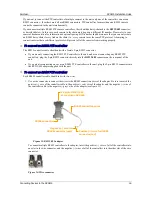
SerVision
MVG400 Installation Guide
Connecting Devices to the MVG400
17
2. If multiple PTZ cameras are connected to the unit, configure each camera to use a different ID. For
information about how to do this, refer to the camera documentation.
3. Connect the RS232/485 adapter to the
RS232/485
connector on the rear panel of the unit.
Connecting Sensors
Sensors are devices that detect events such as a door being opened, brakes being pressed, or high G-force pressure.
Up to four dry-contact input sensors can be connected directly to the unit. In addition, if you wish, you can connect
either an ADAM Data Acquisition Module or an IA-3126-2 relay board to the unit. Either of these devices makes it
possible to connect up to 16 additional sensors to the unit.
Sensor 1 and Sensor 4 can be used as switches instead of sensors. The switches can be used to activate outlines and
to change the display on a CCTV monitor.
Connecting a Sensor Directly to the Unit
The unit has four sensor connectors (
In1
–
In4
). You can use these connectors to connect up to four dry-contact
input sensors directly to the unit. Alternatively,
In1
and
In4
can be used to connect switches as follows:
•
In1:
If you are defining more than one outline (alternate sets of recording and event-handling settings), you
can connect a toggle (on-off) switch to
In1
instead of a sensor. The switch can then be used to change the
active outline. For additional information, please refer to the
Embedded Video Gateway System Guide
.
Note:
Some alarm panels can also be connected to
In1
. When they are, they can function as automatic outline
toggle switches. For additional information, please consult the alarm panel vendor.
•
In4:
If a CCTV monitor will be connected to the unit, you can connect a push-button switch to
In4
instead of
a sensor. The button can then be used to change the display on the monitor. For additional information, see
Connecting a CCTV Monitor
, page 24 and refer to the
Embedded Video Gateway System Guide
.
To connect a sensor or sw itch directly to the unit:
1. Install the sensor or switch in its desired location in accordance with the manufacturer's instructions.
2. Connect the two wire contacts of the sensor or switch to the Sensors terminal block on the rear panel of the
MVG400, as illustrated in figure 15. Insert the wires into the connectors and tighten the screws below each
connector to hold the wires in place.
Note:
The wires must be connected to two adjacent contacts in the same group (e.g. the two contacts of
“
In1
”), but the polarity does not matter.
Figure 15: Connecting a sensor
3. If the sensor requires an external power supply, connect it to the vehicle battery or another power supply.
Note:
You may be able to supply power to the sensor by connecting it to the
12VDC Power Out
connector on
the rear panel of the unit (see
Using the 12VDC Power Out Connector
, page 38).
In1 In2 In3 In4
Sensor
Sensors terminal block
MVG400 rear panel
















































